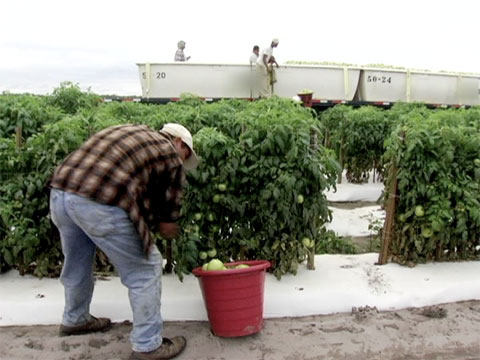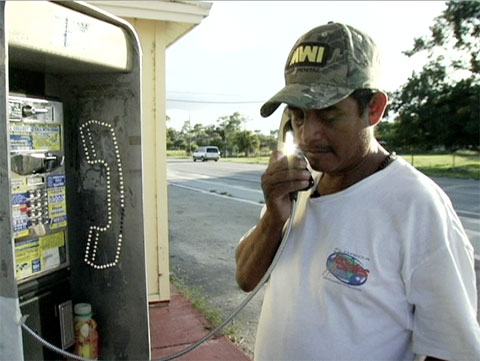Immokalee U.S.A.: Bleak but sympathetic view of migrant farmworkers’ conditions
By James Brewer
19 January 2009
 Picking tomatoes: A scene from Immokalee U.S.A.
Picking tomatoes: A scene from Immokalee U.S.A.Directed by Georg Koszulinski
Immokalee U.S.A., the documentary distributed in DVD format by Substream Independent Films, describes itself as “an account of migrant farmworkers in the U.S.A.”
The notes cite this comment from the Maine International Film Festival: “What is our collective role in this chain of servitude? the film seems to ask us, providing an opening for self-reflection rather than didactic sermonizing.”
The film, directed by Georg Koszulinski, begins slowly and makes clear from the start that it aims to present the reality of the life of the migrant worker without any intervening point of view. It opens with scenes of different stages of the agricultural process of tomato growing, from planting to harvesting, packing, warehousing and shipping.
First, these processes are shown with as few people as possible, focusing on their mechanization. Little by little, we see glimpses of the labor force, initially in dark scenes of the Bluebird buses loading up with anonymous looking workers and moving out to the fields well before dawn.
We also see that not everyone who shows up gets to work. A worker is turned away after having traveled to Immokalee, Florida—in the southern part of the state, 120 miles northwest of Miami—on the promise of work. He says he has been there fifteen days, and there is nothing for him. We encounter him later, numerous times throughout the film, on each occasion more demoralized.
 An unemployed worker repeatedly tries to make contact with his family in Mexico
An unemployed worker repeatedly tries to make contact with his family in Mexico
It takes a certain effort to watch the film’s opening sequences. The viewer is presented with a bleak and rather uninteresting image of this industry, apparently to transmit the harshness of the life the workers are compelled to endure. It becomes more engaging when we get a glimpse of the mothers and children left behind in the trailer camps, as they get ready for school. Initially though, these scenes are without dialog of any kind, forcing us to draw our own conclusions from the images we see. Cute kids, devoted mothers, in many ways like the typical American family.
Eventually dialog is introduced. The children speak the most directly, sometimes to each other, sometimes to the camera. “The man that lives over there hates my daddy, he wants to kill my daddy,” “Mommy says when I'm old enough, I will have to work, but I don't want to. It´s so hard.”
We overhear charity workers trying to raise funds for relief projects in the community. The hopeless worker speaks about his condition, unable to gain employment in the fields, and feeling lost and abandoned in this strange country far from his birthplace. He can't get money for a telephone call home. Yet his pride won't allow him to accept charity. He wants to work and provide for his family.
A crew boss puts forward the company’s view. He is not totally unsympathetic to the plight of the workers, but his outlook is shaped entirely by the needs of production. “These are the only people who will do this work. Americans won’t do it. I take care of my workers. All the bad things you hear about aren’t any of the farmers’ [growers’] fault. There are bad people all over. But it all comes back to the farmer.”
Pictured also are devoted community workers who seek to provide those in need with healthy meals and shelter.
In general, Immokalee, U.S.A. presents a highly sympathetic and sincere view of the migrant workers’ conditions, but it is limited by the liberal outlook with which it is imbued. We are presented with a sense of the striving of the children and the hopefulness of their mothers for a better future.
How is this to come about?
This is the fundamental weakness of the film. It’s one thing to make a film that doesn’t lecture and allows for some spontaneity, permitting an audience to reflect and think for itself. But a thoroughly hands-off “see for yourself” approach to filmmaking sidesteps the critical issues. The filmmaker’s responsibility lies in drawing certain conclusions.
Workers are not simply victims. Nor do migrant laborers face their conditions of life in isolation. They, like all other workers, will be compelled to seek ways to unite with their class as a whole and struggle for their interests.
Notable films (documentary or otherwise) in the past about migrant workers, such as Salt of the Earth, El Norte, even The Grapes of Wrath, had a forcefulness in their depiction of this inclination of the working class to fight against the conditions they face.
Recent decades and global economic changes have brought about the protracted death agony of the official, nationally-based labor movement in the US and exposed its leadership, including the United Farm Workers union, as corrupt and bankrupt.
For decades the AFL-CIO bureaucracy has subsisted on national chauvinism, anticommunism and class collaboration. Union officials, along with Democratic Party liberals and those who make up the leadership of the so-called “civil rights” movement, are indifferent to the plight of the most oppressed layers of the population.
The documentary makers take up an important subject, but what they do with it has a great deal to do with some of these difficulties.
Immokalee U.S.A. is a serious effort at documenting social conditions. Its shortcomings are perhaps not so much the fault of the filmmakers as they are products of the period.





Follow the WSWS